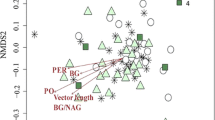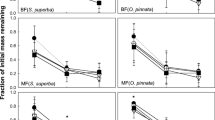Abstract
We designed and carried out a short-term litter decomposition experiment to test the direct effects of litter manipulations on soil nutrients and litter invertebrates in a tropical lowland forest and a diverse subtropical montane evergreen broad-leaved forest in southern China. Our experimental design involved testing both litter quantity and litter quality. To test for the effects of litter quantity, we manipulated different depths of mixed litter, with and without periodic topping-up. To test for the effects of litter quality, we compared four different species of litter individually with mixed, natural, litter control plots. The response by soil nutrients to these manipulations was monitored using ion-exchange membranes and the response by litter invertebrates was estimated using pitfall traps. We show a clear difference in the available soil nutrients and litter invertebrate composition between the two sites. The only response detected in the more diverse montane forests was an invertebrate response to litter quantity. In contrast, we detected both nutrient and invertebrate responses to litter quantity and an invertebrate response to litter species (quality) in the lower diversity forests. We conclude that many of the differences may be attributed to the general temperature and rainfall conditions at the two sites. At the local scale, differences in soil nutrients and invertebrate abundance may partially be explained by litter quantity and the diversity of the forests, and litter abundance has a more significant impact on soil nutrients and litter invertebrates than litter species composition.





Similar content being viewed by others
Notes
Total N as a sum of NO3 and NH4 levels.
References
Aerts R (1997) Climate, leaf litter chemistry and leaf litter decomposition in terrestrial ecosystems: a triangular relationship. Oikos 79:439–449 (ISSN 0030-1299)
Arpin P, Ponge JF, Vannier G (1995) Experimental modifications of litter supplies in a forest mull and reaction of the nematode fauna. Fund Appl Nematol 18:371–389 (ISSN 1164-5571195104)
Ayres E, Steltzer H, Simmons BL, Simpson RT, Steinweg JM, Wallenstein MD, Mellor N, Parton WJ, Moore JC, Wall DH (2009) Home-field advantage accelerates leaf litter decomposition in forests. Soil Biol Biochem 41:606–610. doi:10.1016/j.soilbio.2008.12.022
Ball BA, Carrillo Y, Molina M (2014) The influence of litter composition across the litter-soil interface on mass loss, nitrogen dynamics and the decomposer community. Soil Biol Biochem 69:71–82. doi:10.1016/j.soilbio.2013.10.048
Barajas-Guzmán G, Alvarez-Sánchez J (2003) The relationship between litter fauna and rates of litter decomposition in a tropical rain forest. Appl Soil Ecol 24:91–100. doi:10.1016/S0929-1393(03)00069-6
Burghouts T, Ernsting G, Korthals G, De Vries T (1992) Litterfall, leaf litter decomposition and litter invertebrates in primary and selectively logged dipterocarp forest in Sabeh, Malaysia. Philos Trans R Soc Lond 335:407–416. doi:10.1098/rstb.1992.0032
Cao M, Zou X, Warren M, Zhu H (2006) Tropical forests of Xishuangbanna, China. Biotropica 38:306–309. doi:10.1111/j.1744-7429.2006.00146.x
Carrillo Y, Ball BA, Bradford MA, Jordan CF, Molina M (2011) Soil fauna alter the effects of litter composition on nitrogen cycling in a mineral soil. Soil Biol Biochem 43:1440–1449. doi:10.1016/j.soilbio.2011.03.011
Carrillo Y, Ball BA, Strickland MS, Bradford MA (2012) Legacies of plant litter on carbon and nitrogen dynamics and the role of the soil community. Pedobiologia 55:185–192. doi:10.1016/j.pedobi.2012.02.002
Corbeels M (2001) Plant litter and decomposition: General concepts and model approaches. Paper presented at the NEE workshop proceedings, Canberra, Australia, 18–20 April 2001
Couteaux MM, Mousseau M, Celerier ML, Bottner P (1991) Increased atmospheric CO2 and litter quality: decomposition of sweet chestnut leaf litter with animal food webs of different complexities. Oikos 61:54–64. doi:10.2307/3545406
Couteaux MM, Bottner P, Berg B (1995) Litter decomposition, climate and litter quality. Trends Ecol Evol 10:63–66. doi:10.1016/S0169-5347(00)88978-8
David JF, Ponge JF, Arpin P, Vannier G (1991) Reactions of the macrofauna of a forest mull to experimental perturbations of litter supply. Oikos 61:316–326. doi:10.2307/3545239
Gong H, Yang G, Lu Z, Liu Y (2011) Diversity and spatial distribution patterns of trees in an evergreen broad-leaved forest in the Ailao Mountains, Yunnan. Biodivers Sci 19:143–150. doi:10.3724/SP.J.1003.2011.08313 (in Mandarin with English Abstract)
Heal OW, Anderson JM, Swift MJ (1997) Plant litter quality and decomposition: an historical overview. In: Cadisch G, Giller KE (eds) Driven by nature. Plant litter quality and decomposition. CAB International, Wallingford, pp 3–30
Hobbie SE, Reich PB, Oleksyn J, Ogdahl M, Zytkowiak R, Hale C, Karolewski P (2006) Tree species effects on decomposition and forest floor dynamics in a common garden. Ecology 87:2288–2297
Hooper DU, Solan M, Symstad A, Diaz S, Gessner MO, Buchmann N, Degrange V, Grime P, Hulot F, Mermillod-Blondin F, Roy J, Spehn E, van Peer L (2002) Species diversity, functional diversity, and ecosystem functioning. In: Loreau M, Naeem S, Inchausti P (eds) Biodiversity and ecosystem functioning: synthesis and perspectives. Oxford University Press, Oxford, pp 195–208
Hooper DU, Chapin FS III, Ewel JJ, Hector H, Inchausti P, Lavorel S, Lawton JH, Lodge DM, Loreau M, Naeem S, Schmid B, Setälä H, Symstad AJ, Vandermeer J, Wardle DA (2005) Effects of biodiversity on ecosystem functioning: a consensus of current knowledge. Ecol Monogr 75:3–35
King RF, Dromph KM, Bardgett RD (2002) Changes in species evenness of litter have no effect on decomposition processes. Soil Biol Biochem 34:1959–1963. doi:10.1016/S0038-0717(02)00204-3
Li HT, Chen CH, Hong ZL, Huang JC, Chen CY (2012) Chemical constituents from the leaves of Cinnamomum burmannii. Chem Nat Compd 48:873–874. doi:10.1007/s10600-012-0406-y
Liu WY, Fox JED, Xu ZF (2000) Leaf litter decomposition of canopy trees, bamboo and moss in a montane moist evergreen broad-leaved forest in Ailao Mountain, Yunnan, south-west China. Ecol Res 15:435–447. doi:10.1046/j.1440-1703.2000.00366.x
Liu WY, Fox JED, Xu ZF (2002) Litterfall and nutrient dynamics in a montane moist evergreen broad-leaved forest in Ailao mountains, SW China. Plant Ecol 164:157–170. doi:10.1023/A:1021201012950
Loranger G, Ponge JF, Lambert D, Lavelle P (2002) Leaf decomposition in two semi-evergreen tropical forests: influence of litter quality. Biol Fertil Soils 35:247–252. doi:10.1007/s00374-002-0467-3
Lu XT, Yin JX, Tang JW (2010) Structure, tree species diversity and composition of tropical seasonal rainforests in Xishuangbanna, South-west China. J Trop For Sci 22:260–270
McCune B, Mefford MJ (2006) PC-ORD: multivariate analysis of ecological data, version 5.31. MjM Software, Gleneden Beach
Negrete-Yankelevich S, Fragoso C, Newton AC, Russell G, Heal OW (2008) Species-specific characteristics of trees can determine the litter macroinvertebrate community and decomposition process below their canopies. Plant Soil 307:83–97. doi:10.1007/s11104-008-9585-5
Orwin KH, Wardle DA, Greenfield LG (2006) Context-dependent changes in the resistance and resilience of soil microbes to an experimental disturbance for three primary plant chronosequences. Oikos 112:196–208. doi:10.1111/j.0030-1299.2006.13813.x
Parton W, Silver WL, Burke IC, Grassens L, Harmon ME, Currie WS, King JY, Adair EC, Brandt LA, Hart SC, Fasth B (2007) Global-scale similarities in nitrogen release patterns during long-term decomposition. Science 315:361–364. doi:10.1126/science.1134853
Penuelas J, Sardans J, Llusia J, Owen SM, Silva J, Niinemets U (2010) Higher allocation to low cost chemical defenses in invasive species of Hawaii. J Chem Ecol 36:1255–1270. doi:10.1007/s10886-010-9862-7
Qian P, Schoenau JJ (2002) Practical applications of ion exchange resins in agricultural and environmental soil research. Can J Soil Sci 82:9–21. doi:10.4141/S00-091
Qiu XZ, Xie SC, Liu WY (1998) Studies on the forest ecosystem in Ailao Mountains, Yunnan, China. Yunnan Sciences and Technology Press, Kunming
Richardson BA, Richardson MJ, Soto-Adames FN (2005) Separating the effects of forest type and elevation on the diversity of litter invertebrate communities in a humid tropical forest in Puerto Rico. J Anim Ecol 74:926–936. doi:10.1111/j.1365-2656.2005.00990.x
Rodriguez-Castaneda G, Dyer LA, Brehm G, Connahs H, Forkner RE, Walla TR (2010) Tropical forests are not flat: how mountains affect herbivore diversity. Ecol Lett 13:1348–1357. doi:10.1111/j.1461-0248.2010.01525.x
Sayer EJ (2006) Using experimental manipulation to assess the roles of leaf litter in the functioning of forest ecosystems. Biol Rev Camb Philos Soc 81:1–31. doi:10.1017/S1464793105006846
Sayer EJ, Tanner EVJ, Lacey AL (2006) Effects of litter manipulation on early-stage decomposition and meso-arthropod abundance in a tropical moist forest. For Ecol Manag 229:285–293. doi:10.1016/j.foreco.2006.04.007
Sayer EJ, Sutcliffe LME, Ross RIC, Tanner EVJ (2010) Arthropod abundance and diversity in a lowland tropical forest floor in Panama: the role of habitat space vs. nutrient concentrations. Biotropica 42:194–200. doi:10.1111/j.1744-7429.2009.00576.x
Sayer EJ, Wright SJ, Tanner EVJ, Yavitt JB, Harms KE, Powers JS, Kaspari M, Garcia MN, Turner BL (2012) Variable responses of lowland tropical forest nutrient status to fertilization and litter manipulation. Ecosystems 15:387–400. doi:10.1007/s10021-011-9516-9
SPSS Statistics (2011) SPSS 20.0 SPSS Inc., Chicago, IL
Strickland MS, Lauber C, Fierer N, Bradford MA (2009) Testing the functional significance of microbial community composition. Ecology 90:441–451. doi:10.1890/08-0296.1
Sylvain ZA, Wall DH (2011) Linking soil biochemistry and vegetation: implications for a changing planet. Am J Bot 98:517–527. doi:10.3732/ajb.1000305
Tanner EVJ, Vitousek PM, Cuevas E (1998) Experimental investigation of nutrient limitations of forest growth on wet tropical mountains. Ecology 79:10–22. doi:10.2307/176860
Uetz GW (1979) The influence of variation in litter habitats on spider communities. Oecologia 40:29–42. doi:10.1007/BF00388808
Vitousek PM, Sanford RL (1986) Nutrient cycling in moist tropical forest. Annu Rev Ecol Syst 17:137–167. doi:10.1146/annurev.es.17.110186.001033
Walker B, Kinzig A, Langridge J (1999) Plant attribute diversity, resilience, and ecosystem function: the nature and significance of dominant and minor species. Ecosystems 2:95–113. doi:10.1007/s100219900062
Wardle DA, Yeates GW, Barker GM, Bonner KI (2006) The influence of plant litter diversity on decomposer abundance and diversity. Soil Biol Biochem 38:1052–1062. doi:10.1016/j.soilbio.2005.09.003
Yang XD (2004) Dynamics and community structure of soil meso-microarthropods during leaf litter decomposition in tropical seasonal rain forests of Xishuangbanna, Yunnan. Biodivers Sci 12:252–261
Yang XD, Chen J (2009) Plant litter quality influences the contribution of soil fauna to litter decomposition in humid tropical forests, southwestern China. Soil Biol Biochem 41:910–918. doi:10.1016/j.soilbio.2008.12.028
Yang XD, Warren M, Zhou XM (2007) Fertilization responses of soil litter fauna and litter quantity, quality, and turnover in low and high elevation forests of Puerto Rico. Appl Soil Ecol 37:63–71. doi:10.1016/j.apsoil.2007.03.012
Young SS, Herwitz SR (1995) Floristic diversity and co-occurrences in a subtropical broad-leaved forest and two contrasting regrowth stands in central-west Yunnan Province, China. Vegetation 119:1–13. doi:10.1007/BF00047366
Young SS, Carpenter C, Zhi-Jun W (1992) A study of the structure and composition of an old growth and secondary broad-leaved forest in the Ailao Mountains of Yunnan, China. Mt Res Dev 12:269–284. doi:10.2307/3673670
Zhang RQ, Sun ZJ, Wang C, Yuan TY (2009) Ecological process of leaf litter decomposition in tropical rainforest in Xishuangbanna, southwest China. III. Enzyme dynamics. Front For China 4:28–37. doi:10.1007/s11461-009-0012-8
Zheng Z, Shanmughavel P, Sha LQ, Cao M, Warren M (2006) Litter decomposition and nutrient release in a tropical seasonal rain forest of Xishuangbanna, Southwest China. Biotropica 38:342–347. doi:10.1111/j.1744-7429.2006.00151.x
Zhu H, Cao M, Hu HB (2006) Geological history, flora, and vegetation of Xishuangbanna, southern Yunnan, China. Biotropica 38:310–317. doi:10.1111/j.1744-7429.2006.00147.x
Acknowledgments
This research was funded by the Natural Sciences and Engineering Research Council of Canada (to RT), the National Basic Research Program of China, 973 Program (No. 2012CB821900; to ZZ-K) and the CAS 135 program (XTBG-F01; to ZZ-K). We are grateful to those who helped in the field (Hu Jin Jin, Wang Li, Su Tao, Mr. Luo, Lainie Qie, Hu Qian, Liu Qiang, Li Jiangwu, and Lu Yun), and those who provided statistical advice (Bill Harrower, Jennie McLaren, Lizzie Wolkovich, and Kyle Demes). We are especially grateful to the staff at both Xishuangbanna Tropical Botanical Garden, and the Ailaoshan Forest Ecosystem Research Station for logistical support and for the use of labs and equipment.
Author information
Authors and Affiliations
Corresponding author
Additional information
Communicated by Prof. Lauchlan Fraser, Dr. Chris Lortie and Dr. JC Cahill.
Electronic supplementary material
Below is the link to the electronic supplementary material.
Rights and permissions
About this article
Cite this article
Lu, J., Turkington, R. & Zhou, Zk. The effects of litter quantity and quality on soil nutrients and litter invertebrates in the understory of two forests in southern China. Plant Ecol 217, 1415–1428 (2016). https://doi.org/10.1007/s11258-016-0600-2
Received:
Accepted:
Published:
Issue Date:
DOI: https://doi.org/10.1007/s11258-016-0600-2




